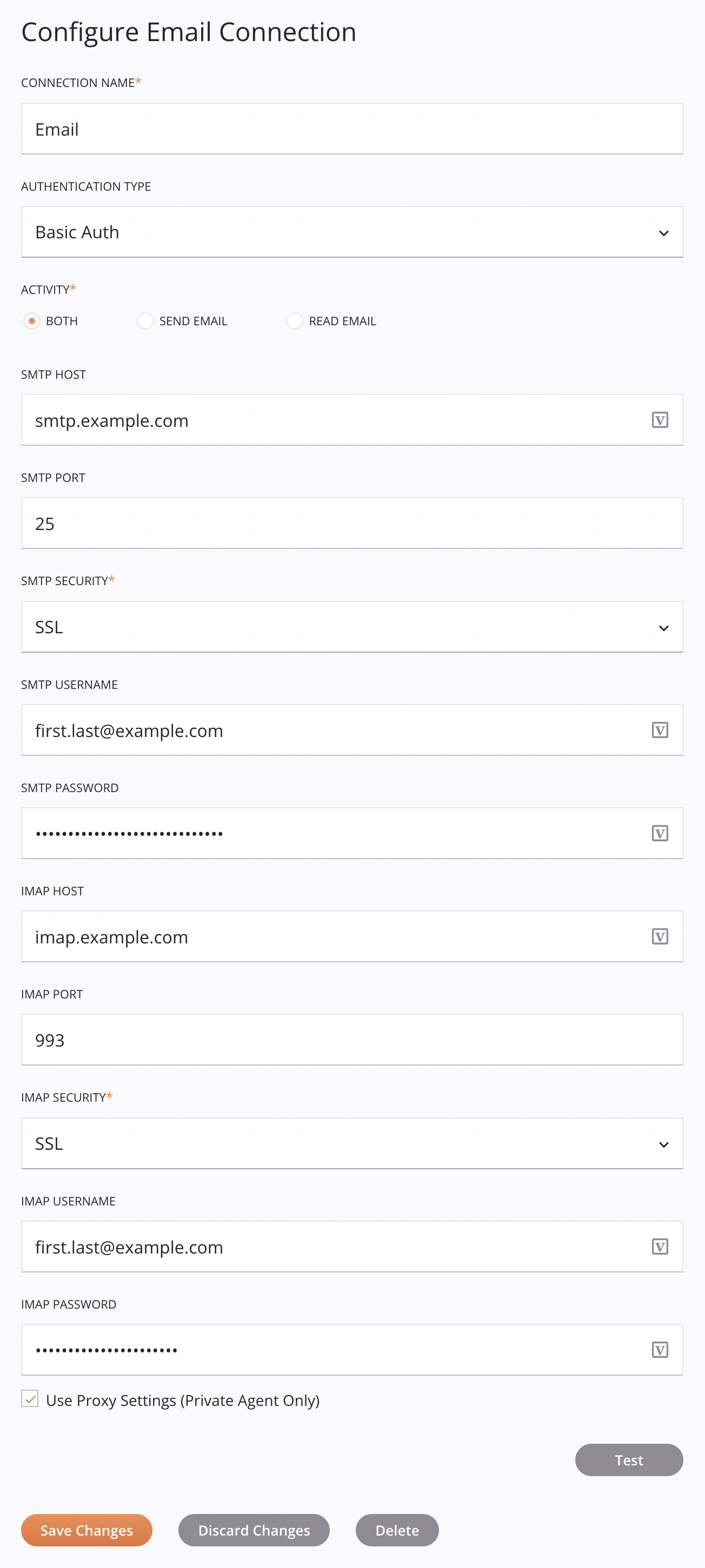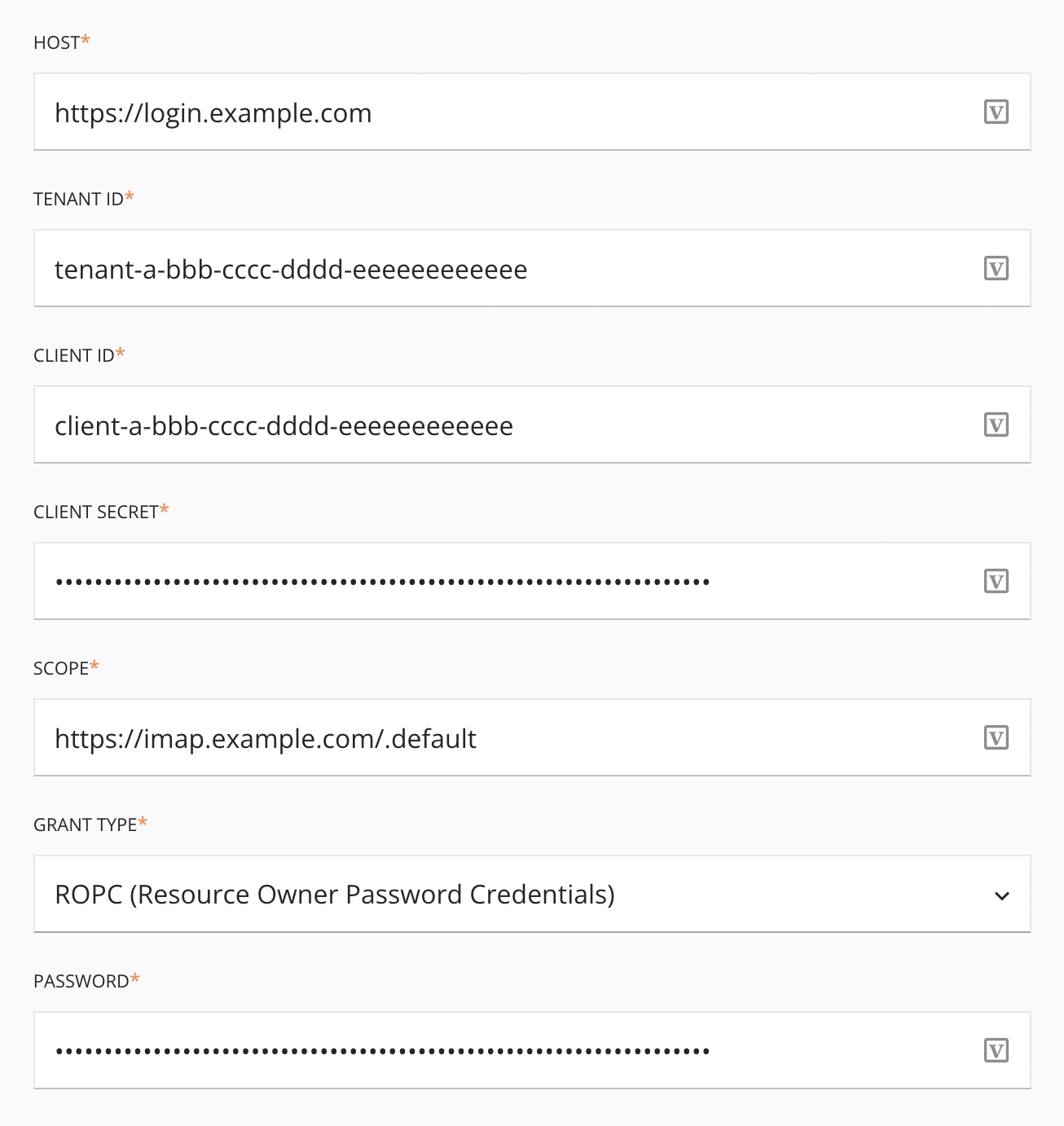Email connection
Introduction
An Email connection, created using the Email connector, establishes access to an email server. Once a connection is configured, you can create instances of Email activities associated with that connection to be used either as sources (to provide data in an operation) or as targets (to consume data in an operation).
Important
Using the Email connector with Microsoft 365 requires additional prerequisites to be met. See Email prerequisites for a Microsoft 365 OAuth 2.0 connection.
For additional information on Microsoft 365 email endpoint settings, see Microsoft's POP, IMAP, and SMTP settings documentation.
Create or edit an email connection
A new Email connection is created using the Email connector from one of these locations:
- The design component palette's Project endpoints and connectors tab (see Design component palette).
- The Global Connections page (see Create a global endpoint in Global Connections).
An existing Email connection can be edited from these locations:
- The design component palette's Project endpoints and connectors tab (see Design component palette).
- The project pane's Components tab (see Component actions menu in Project pane Components tab).
- The Global Connections page (see Edit a global endpoint in Global Connections).
Configure an email connection
Each user interface element of the Email connection configuration screen is described below.

Tip
Fields with a variable icon ![]() support using global variables, project variables, and Jitterbit variables. Begin either by typing an open square bracket
support using global variables, project variables, and Jitterbit variables. Begin either by typing an open square bracket [ into the field or by clicking the variable icon to display a list of the existing variables to choose from.
-
Connection Name: Enter a name to use to identify the connection. The name must be unique for each Email connection and must not contain forward slashes
/or colons:. This name is also used to identify the Email endpoint, which refers to both a specific connection and its activities. -
Authentication Type: Select the authentication method, one of Basic Auth or OAuth2:
-
Basic Auth: SMTP and IMAP server authentication with username and password combinations.
-
OAuth2: Expands additional options for configuring OAuth 2.0 authentication:

-
Host: Enter the host for OAuth authentication.
Tip
For Microsoft Entra ID OAuth authentication, enter
https://login.microsoftonline.comas the host. -
Tenant ID: Enter the tenant ID.
-
Client ID: Enter the client ID.
-
Client Secret: Enter the client secret.
-
Scope: Enter the scope.
-
Grant Type: Select Client Credentials (default) or ROPC (Resource Owned Password Credentials) as the grant type for OAuth authentication. If ROPC (Resource Owned Password Credentials) is selected, you can specify an additional Password.
Important
To send emails through Microsoft 365 (
smtp.office365.com), ROPC (Resource Owned Password Credentials) must be selected for Grant Type. -
Password: Enter a valid password. Visible only if the Grant Type is set to ROPC (Resource Owned Password Credentials).
-
-
-
Activity: Select the activity type to associate with this connection, one of Both, Send Email, or Read Email:
-
Both: The connection will be associated with the Send email and Read email activities. When Both is selected, all fields documented below are displayed.
-
Send Email: The connection will be associated with only the Send email activity. When Send Email is selected, only the fields that begin with SMTP are displayed in the configuration screen.
-
Read Email: The connection will be associated with only the Read email activity. When Read Email is selected, only the fields that begin with IMAP are displayed in the configuration screen.
-
-
SMTP Host: Enter the host name of the SMTP email server. This field is displayed only if the selected Activity is Both or Send Email.
-
SMTP Port: Enter the port number of the SMTP email server with which to connect. The default port is 25. A value in this field is applicable only if the SMTP Security field below is set to None or TLS. If the SMTP Security field is set to SSL, then port 465 is always used regardless of the value entered in the SMTP Port field. This field is displayed only if the Activity type selected above is Both or Send Email.
-
SMTP Security: When the selected Activity type is Both or Send Email, use the menu to select either None, SSL, or TLS.
-
None: The email server does not require authentication.
-
SSL: The email server uses SSL encryption for authentication.
-
TLS: The email server uses TLS encryption for authentication.
-
-
SMTP Username: Enter the username (if required by the SMTP email server).
-
SMTP Password: Enter the password (if required by the SMTP email server). Visible only if Authentication Type is set to Basic Auth.
Note
When connecting to Gmail, enter an app password instead of the account password.
-
IMAP Host: Enter the host name of the IMAP email server with which to connect. This field is displayed only if the Activity type selected above is Both or Read Email.
-
IMAP Port: Enter the port number of the IMAP email server with which to connect. The default port is 993. This field is displayed only if the Activity type selected above is Both or Read Email.
-
IMAP Security: When the selected Activity type is Both or Read Email, use the menu to select either None, SSL, or TLS.
-
None: The email server does not require authentication.
-
SSL: The email server uses SSL encryption for authentication.
-
TLS: The email server uses TLS encryption for authentication.
-
-
IMAP Username: Enter the username (if required by the IMAP email server).
-
IMAP Password: Enter the password (if required by the IMAP email server). Visible only if Authentication Type is set to Basic Auth.
Note
When connecting to Gmail, enter an app password instead of the account password.
-
Use Proxy Settings (Private Agent Only): When using a private agent, this setting can be selected to use private agent proxy settings. This option is functional only when using OAuth 2.0 as the Authentication Type.
-
Test: Click to verify the connection using the provided configuration. When the connection is tested, the latest version of the connector is downloaded by the agent(s) in the agent group associated with the current environment. This connector supports suspending the download of the latest connector version by using the Disable Auto Connector Update organization policy. The username and password fields for a given protocol are used for verification only if both are present and the security field is set to either SSL or TLS.
-
Save Changes: Click to save and close the connection configuration.
-
Discard Changes: After making changes to a new or existing configuration, click to close the configuration without saving. A message asks you to confirm that you want to discard changes.
-
Delete: After opening an existing connection configuration, click to permanently delete the connection from the project and close the configuration (see Component dependencies, deletion, and removal). A message asks you to confirm that you want to delete the connection.
Next steps
After an Email connection has been created, you place an activity type on the design canvas to create activity instances to be used either as sources (to provide data in an operation) or as targets (to consume data in an operation).
Menu actions for a connection and its activity types are accessible from the project pane and design component palette. For details, see Actions menus in Connector basics.
These activity types are available:
-
Send Email: Sends email using the Simple Mail Transfer Protocol (SMTP) to specified recipients and is intended to be used as a target in an operation.
-
Read Email: Retrieves unread email using the Internet Message Access Protocol (IMAP) and is intended to be used as a source to provide data to an operation.